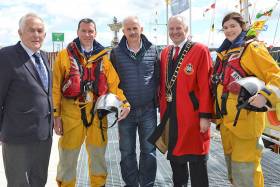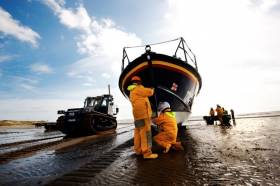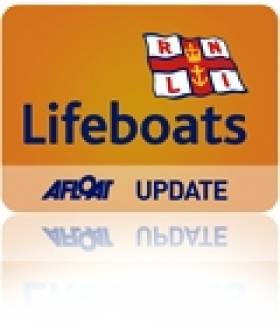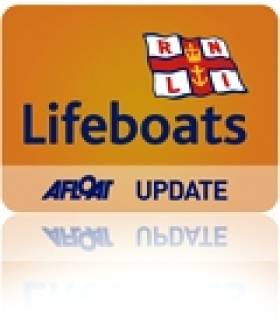Displaying items by tag: Clogherhead
Carrybridge Lifeboat Rescues Cruiser From Rocks
#RNLI - Carrybridge RNLI’s lifeboat and rescue water craft were requested on Wednesday afternoon (23 August) to launch to a 30ft cruiser which had encountered fuel issues and drifted onto rocks on Upper Lough Erne.
The casualty vessel, with two persons on board, was located around a mile north of the Crom Estate in Co Fermanagh. The RNLI crew assisted in refloating the vessel and towed it back to Geaglum Jetty.
Elsewhere, Clogherhead RNLI in Co Louth launched on the same afternoon in response to a report that a razor clam fishing boat was sinking off Drogheda Bar.
While the lifeboat was en route to the scene, the two fishing crew were rescued by the Drogheda Pilot Boat, taken upriver and transferred to an ambulance.
The lifeboat travelled at full speed to the scene and on arrival found the casualty vessel almost totally submerged. The RNLI crew managed to locate the boat's EPRIB among the debris.
Clogherhead RNLI Launches €150K Lifeboat Appeal
#RNLI - Clogherhead RNLI in Co Louth officially launched the station’s €150,000 Shannon lifeboat appeal on the final day of the Drogheda maritime festival yesterday (Sunday 11 June).
The total cost of Clogherhead’s new Shannon class all-weather lifeboat will be in the region of €2.5 million, the majority of which will be provided through an Irish legacy.
However, the lifeboat station must raise €150,000 towards the cost of the project through a community appeal before the lifeboat is due to go on service in 2019.
The current Clogherhead lifeboat, Doris Bleasdale, is a Mersey class that can reach a top speed of 15 knots.
In the last five years, the lifeboat crew in Clogherhead have launched their lifeboat 58 times and brought 60 people to safety.
With a Shannon class lifeboat, designed by Derry man Peter Eyre, those launches will be even faster with its top speed of 25 knots, and improved range and manoeuvrability thanks to its waterjet propulsion, which also allows the vessel to operate in shallow waters and be intentionally beached.
The official launch took place in the presence of the Mayor of Drogheda Oliver Tully and the Drogheda Harbour Master Captain Martin Donnelly on the new pier for visiting yachts at Drogheda Port, which was itself launched at the weekend during the Irish Maritime Festival.
Speaking at the launch, Drogheda Mayor Oliver Tully paid tribute to the Clogherhead lifeboat crew.
“When we hear of the RNLI going to sea we think of Clogherhead and we think of the all the lives you have saved and your predecessors before you. I would like to thank you for the tremendous work that you do. It is the Clogherhead lifeboat but is supported by everyone in the surrounding area.”
The Mayor also hailed lifeboat mechanic Padraig Rath for keeping the current lifeboat in pristine condition for 24 years.
Coxswain Tomas Whelehan added: “We are delighted that this day is finally here and we can announce the news of a Shannon class lifeboat for the east coast. We have been overwhelmed with the goodwill of people and offers of support. This new lifeboat will represent everyone in our communities as well as those who visit our shores for work or pleasure.
“Our lifeboat crew launch in all conditions at any time of night or day to bring loved ones home. The least we can do is give them the very best in lifeboat technology. Not all callouts are rescues and sometimes there is tragedy but whatever the call, our crews are always ready to answer it and our lifeboat always ready to be launched.”
For further details of how to get involved with the Clogherhead RNLI Shannon project, contact the station at 041 982 2600 and follow the Facebook page for updates.
Busy Easter Monday For Clogherhead Lifeboat
#RNLI - It was a busy Easter Monday (17 April) with two consecutive callouts for Clogherhead RNLI in Co Louth.
At 6pm, the all-weather lifeboat was launched to assist a razor boat in difficulty off Mosney in Co Meath. The casualty boat was taken in tow and safely tied up at Skerries.
On returning north to Clogherhead, the volunteer crew were requested at 9.15pm to assists the rescue of three people whose boat upturned on the River Boyne, as previously reported on Afloat.ie.
#RNLI - Clogherhead RNLI has looked back on 2016 and paid tribute to all those who made it such a memorable year for the lifeboat station and its volunteers.
Throughout the year the station worked with other community groups and organisations to promote their work and the Co Louth coastal village, resulting in a busy calendar of events and successful partnerships.
But it was also an eventful year on the water, with lives saved — and sadly lost, too.
Back in March the lifeboat was launched to reports of a distress signal from a fishing vessel located 25 miles east of Clogherhead, recovering its liferaft and beacon after the coastguard winched its three fishing crew to safety.
Later that month, RNLI volunteer lifeboat crew from across Ireland took part in the Easter 1916 centenary commemoration which saw over 700 members of the Irish emergency services taking part in the biggest parade in the history of the state.
Fifty RNLI volunteers came from 29 lifeboat stations around the country to parade through Dublin city centre to mark the centenary. The RNLI formed part of the emergency services section of the parade which recognised the ‘blue light’ agencies serving the Irish State since its foundation.
Representing Clogherhead RNLI was volunteer shore crew member Carolyn Stanley — granddaughter of Joe Stanley, Pádraig Pearse’s press agent and printer.
During the Easter Rising, Pearse relied on Stanley to convert his handwritten communiques into printed documents for onward circulation throughout the city. It was Stanley who published the first documents of the newly proclaimed republic.
In June, four Louth volunteers were honoured at the annual RNLI Awards, held in the Guinness Storehouse, for their contribution to the charity.
Brendan Hoey received a Bar to Gold Badge for his 30 years of volunteering, while Anne Levins, Terry Rath and Deirdre Delaney received Gold Badges for their outstanding contribution to volunteering.
Between them, these volunteers have given thousands of hours to the RNLI, working hard to raise awareness and funds for the work of the charity in Clogherhead.
In July, Clogherhead RNLI threw open its doors to welcome the community in for their annual open day, which enjoyed a record-breaking attendance.
Another highlight of the year was Clogherhead RNLI’s involvement in the Pride of Place competition along with many other community groups and speakers.
The ‘Community Oscars’ saw Clogherhead top the prestigious Island and Coastal Community category. The station was proud to be part of the submission and spoke about their work and involvement in the community highlighting their history and life-saving work.
The summer also saw the Drogheda Maritime Festival take place, and the Clogherhead volunteers brought their all-weather lifeboat down to the quayside.
They also welcomed some VIPs from Belarus, regular visitors to Ireland with the Chernobyl Children’s Charity, to their stand and onboard the lifeboat for a personal tour.
Each year Clogherheard RNLI station mechanic Padraig Rath helps the charity organise the St Stephen’s Day Swim on Clogherhead beach, which last year raised €6,000 for a building project to rehouse children living in institutions.
Sadly the year was not without tragedy, when local man and diver Craig Byrne lost his life in September. The whole village was in mourning, and Craig is remembered with great affection. The thoughts and sympathies of everyone with Clogherhead RNLI are with his family and loved ones.
As the year draws to a close and a new one beckons, Clogherhead RNLI found themselves rescuing Santa Claus and landed him on the beach to be met by local school children.
This followed the popular ‘Polar Plunge’ which was held for Special Olympics on Clogherhead beach and where the lifeboat station was operations hub on the day.
The team will once again round out the year supporting the Chernobyl Swim on St Stephen’s Day. This will be the 16th annual swim and funds raised will assist with the treatment of Chernobyl heart syndrome — a life-threatening condition affecting 6,000 children each year.
Diver Dies After Rescue Off Clogherhead
#Diving - TheJournal.ie reports on the death of a diver who got into difficulty off Clogherhead in Co Louth on Monday (29 August).
Clogherhead RNLI and the local Irish Coast Guard unit were called to the scene around 5.30pm on Monday afternoon, with the Dublin-based Rescue 116 winching the casualty from the water.
He was subsequently airlifted from Port Oriel to Our Lady Of Lourdes Hospital in Drogheda, where he was pronounced dead yesterday morning (Tuesday 30 August).
The Irish Mirror has more on the story HERE.
#RNLI - Clogherhead RNLI's volunteer lifeboat crew launched their all-weather lifeboat at 11:50am yesterday (Sunday 20 March) in response to a distress EPIRB signal received from a fishing vessel located 25 miles east of Clogherhead.
While en route to the location of the signal, the Clogherhead crew was informed that the Irish Coast Guard helicopter Rescue 116 had winched the three people from a liferaft and were proceeding to hospital.
The lifeboat continued on to the signal's location in good weather and calm seas, arriving at the scene at 1:38pm. The liferaft was located and recovered and the EPIRB was found nearby a short time later.
No Time To Lose As Clogherhead Trawler Sunk Without Trace
#RNLI - RNLI Magazine revisits the fateful day last summer off Co Louth when a fishing trawler went under in a matter of minutes.
Despite the clear day and calm seas, as previously reported on Afloat.ie, the razor clam boat with two fishermen on board sank without warning off Port Oriel on Clogherhead after 5pm on 23 August last.
But in a fortunate turn of events, the sinking vessel was seen from a nearby fishing boat skippered by Sean Flanagan – who also happens to be one of the local RNLI's highly trained volunteer crew.
Flanagan got on the phone to deputy coxswain Tomas Whelahan to spark the lifeboat launch before calling in a Mayday and going to the aid of the sinking boat along with his son Donal.
From the deck of their Naomh Óisín, they could spot smoke rising from the engine of the stricken vessel, and getting closer they could see it was listing badly.
So there was no time to lose: once Sean had radioed details to the Dublin Coast Guard, he and Donal hauled their gear and made haste to the sinking boat and its two-man crew now vulnerable in the water.
RNLI Magazine has much more on the story HERE.
Clogherhead Lifeboat Crewman Rescues Two After Fishing Boat Sinks
#RNLI - A lifeboat crewmember from Clogherhead RNLI has been praised for his swift actions in rescuing two men from a fishing vessel that sank at the weekend.
Sean Flanagan and his son were fishing approximately two miles away from Port Oriel in Co Louth on Saturday 23 August when they noticed a Razor fishing boat sink a mile in the distance shortly before 5.30pm.
Flanagan, a highly trained volunteer crewmember, raised the alarm and made a Mayday call. He quickly hauled his gear and made best speed to the scene where he found two men in the water alongside their sunken boat.
Together with his son, Flanagan successfully pulled the men out of the water and into the safety of his vessel.
Meanwhile, Clogherhead RNLI’s all-weather lifeboat under coxswain Tomas Whelan and with four crewmembers on board had launched and made its way to the scene. The Dublin-based Irish Coast Guard helicopter Rescue 116 was also tasked.
Weather conditions at the time were described as good with clear visibility and a calm sea state.
The casualties were transferred to the lifeboat on arrival where they were medically assessed by lifeboat crew. They were then airlifted by helicopter to Our Lady of Lourdes Hospital in Drogheda.
Speaking following the callout, Whelan said: "We have to commend the swift actions of our lifeboat crew member Sean Flanagan who not only made the Mayday call for the emergency services but then rapidly went to the scene and rescued the two men from the sea."
Arranmore Lifeboat Assists Two Yachts In Poor Weather
#RNLI - Arranmore RNLI in Donegal has assisted nine people after two yachts got into difficulty within five hours earlier this week.
At 12.30pm on Wednesday 2 July, the volunteer lifeboat crew responded to a call for assistance from a yacht which had got into difficulty west of Bloody Foreland.
The 37ft yacht, with seven crew members on board, was experiencing problems with its engine and sails.
On arrival, the lifeboat crew stood by. but with deteriorating weather conditions and a 3-4 metre swell, coxswain Anton Kavanagh decided to escort the yacht to safety until it was safe to secure a tow rope.
As both the lifeboat and the yacht reached the lee side of Arranmore at Beal a’ Chreesh, the crew managed to secure a tow and brought the vessel into Burtonport, where two of the yacht’s injured crew were then transferred to Letterkenny General Hospital by ambulance.
Meanwhile, at around 2.15pm another 10m yacht with two crew members on board got into difficulty eight miles northwest of Arranmore when the vessel’s boom broke.
With no immediate danger, the skipper of the yacht began to make his way towards Burtonport until the lifeboat could return from its first call and escort them into harbour as a safety precaution in what were rapidly deteriorating weather conditions.
Speaking after both rescues, Arranmore RNLI mechanic Philip McCauley said: "For four to six weeks we were quiet and now have responded to six calls in just under two weeks, but I suppose that’s the nature of the business we are in and the volunteer lifeboat crew will always be ready to go out whenever we get the call.
"We were pleased to assist both casualty vessels and their crews today; it is all part of the service."
The lifeboat station at Arranmore is experiencing one of its busiest summers with calls for assistance to help locate missing swimmers, rescue injured fishermen and carry out medical evacuations.
Elsewhere, the Clogherhead RNLI volunteer lifeboat crew launched yesterday morning (Friday 4 July) to the aid of a fishing vessel with engine failure located 3 miles north-east of Dunany Point in Co Louth.
The all-weather lifeboat was launched and underway by 7.25am. On arrival at the scene, coxswain Tomas Whelahan and his crew assessed the situation, and together with the skipper of the casualty vessel it was decided to tow the disabled vessel to Port Oriel.
There were no injuries and the boat was safely tied up at 10:24am.
Ireland's Oldest Wooden Boats Aren't Getting Any Younger
#woodenboats – On Midsummer's Day, W M Nixon looks back on the already busy and event-filled Irish season of 2014, and reflects on the extraordinary longevity of some boats, their remarkable variety, and the diverse characters who own them.
When I shipped aboard the former Bristol Channel Pilot cutter Madcap to sail the Old Gaffers Division in Howth Yacht Club's Lambay Race on June 7th, it wasn't the first time I'd been out and about on a boat built in the 1870s. But as most of my experiences on John and Sandra Lefroy's 1873-vintage iron-built classic 58ft Victorian steam yacht Phoenix on Lough Derg took place in the 1970s with the most recent jaunt being way back in 1982, sailing on the Madcap was indeed the first time afloat in a boat built 140 years ago.
It takes an effort to get your head around the most basic notion of such an age. You find yourself reflecting on the delights that still awaited the human race at the time, things that were still far into the remote future in the 20th Century. During the 1870s, industrialisation was still gaining traction, but the very idea of warfare on the industrial scale which was to be experienced in the Great War of 1914-18 was beyond most people's imagination, and way beyond anyone's experience. That said, there were more than enough other ways of experiencing an early death, with a range of particularly unpleasant illnesses which have been largely eliminated today.
Yet it was increasing industrialisation which created the circumstances that enabled both boats to be built. The Bristol Channel Pilot cutters evolved rapidly in the latter half of the 19th Century in order to provide pilots for the more numerous and increasingly large ships which were coming into ports such as Cardiff and Bristol. They reached their peak of performance around 1900, by which time they'd achieved a remarkable stage of development, being fast and able, yet comfortable at sea, and capable of being handled by a very small crew after the pilots had been delivered to incoming vessels. When their working days were over as they were replaced by motorised vessels, they proved ideal as seagoing cruising yachts.
There was nothing work-oriented about the pleasure yacht Phoenix when she was built to the designs of Andrew Horn in Waterford in 1873. Or maybe that's being a bit naïve. After all, she is down as having been built by and for the Malcolmsons of Waterford. They were a remarkable clan who brought many industries to Waterford in the 19th Century, and they created the miniature industrial town of Portlaw westward from the city, off the south bank of the Suir Estuary.
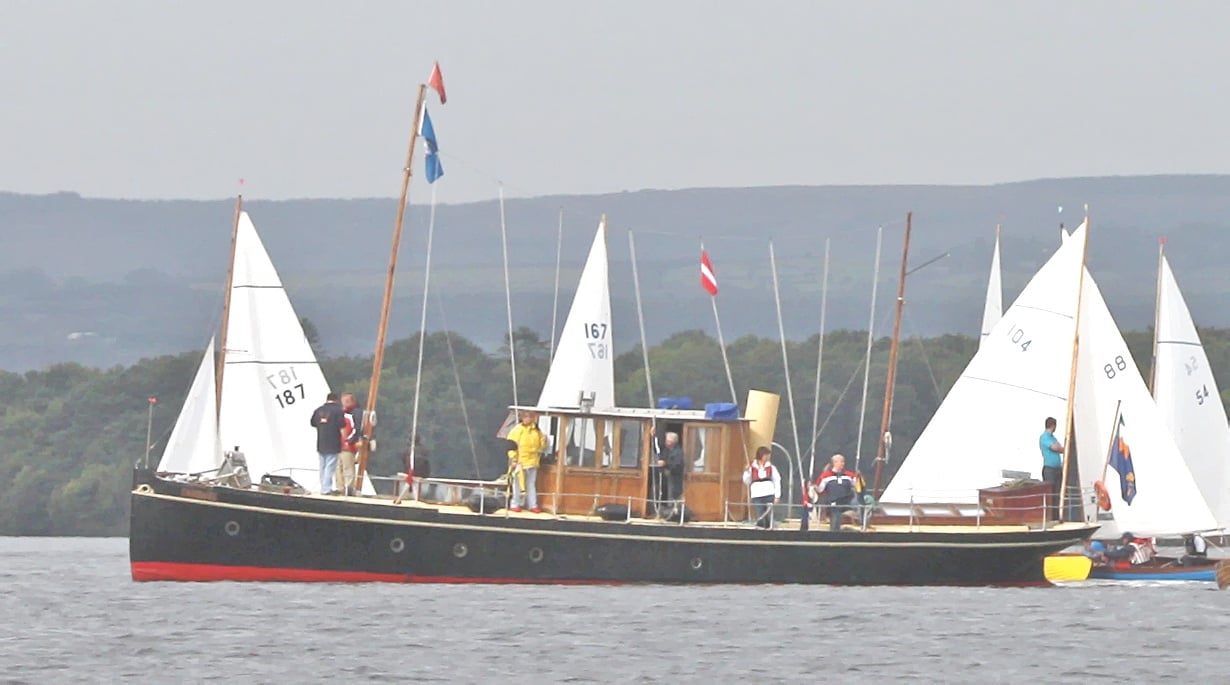
The 58ft Phoenix, iron-built in Waterford in 1873, performing Committee Boat duties at Dromineer for Lough Derg YC. Photo: Gerardine Wisdom
So in building the Phoenix themselves, so to speak, they were creating a subtle advertisement for Waterford expertise, with this new miniature of an ocean liner being constructed in the highly-regarded Lowmoor iron. And she's a powerful statement - this lovely old vessel has lasted much better than many of the Waterford enterprises which outshone her at the time of her building, so much so that if, in Waterford's current recessional woes, they sought something to symbolise what the city is capable of, they would do worse than put some resources the way of the Phoenix for her continuous maintenance.
Five years ago she made a very stylish appearance as the Committee Boat in a classics regatta at Dromineer, and that in turn produced an astonishing photo which included Ian Malcolm's 1898-built Howth 17 Aura. It was the first time a jackyard topsail had been seen on Lough Derg since before the Great War, and all that together with a raft of Shannon One Designs (which date from 1922 onwards) and a fleet of Dublin Bay Water Wags from 1902 onwards meant that the total age of the boat in the photo was pushing towards the 2,000 years mark.

Phoenix and the 1898 Howth 17 Aura (Ian Malcolm) at Dromineer with rafts of Shannon ODs and Water Wags. The combined age of the bots in the photo is well over a thousand years. Photo: Gerardine Wisdom
To be aboard Phoenix is to be transported right back to the 1870s, as she has a beam of only 10.5ft, which on a length of 58.5ft make for one very slim and potent hull. She has long since had her original steam engine replaced with a diesel, and back in 1982 when I was last afloat in her, it was October, and we were the Committee Boat for the annual IYA Helmsmans Championship, raced that year in Shannon One Designs with Dave Cummins of Sutton the winner, crewed by Gordon Maguire.
Being late season, the Phoenix's injectors needed a clean, but as the Race Officers were those perpetual schoolboys Jock Smith and Sam Dix of Malahide, they were delighted by the Phoenix's ability to emit a fine plume of smoke from her funnel at full speed, and after the championship was resolved they tore across the lively waters of Autumnal Lough Derg at full speed while – from another boat - I grabbed some photos which made Phoenix look like a destroyer in action at the Battle of Jutland. One of them subsequently appeared as the cover of Motor Boat & Yachting, and as I seem to have mislaid the colour slides, if anyone has a copy of that particular edition I'd much appreciate a scan of it.
Moving on from the 1873-built Phoenix in 1982 to the 1874-built Madcap in 2014 is quite some saga, but we'll edit it by sticking to events this year revolving around the developing annual Old Gaffer programme in the Irish Sea. Last year Dickie Gomes' 1912-built 36ft John B Kearney yawl Ainmara from Strangford Lough won the inaugural Leinster Trophy race in Dublin Bay which marked the OGA's Golden Jubilee, and she did it despite now being bermuda rigged. But as she was returning to her birthplace in Ringsend for the first time in 90 years, she was treated as an honorary gaffer.
Honour being the theme of things, this meant we were honour-bound to bring her south again to defend the Leinster in 2014, but this was given an added impetus by a plan to link up in Dun Laoghaire with Martin Birch's 1902-built Espanola out of Preston in Lancashire. From 1912 until 1940, the 47ft Espanola was a feature of the Royal Irish YC in Dun Laoghaire, owned by noted sailor Herbert Wright, who in 1929 became the founding Commodore of the Irish Cruising Club when he cruised Espanola with four other yachts to Glengarriff where the ICC was founded on July 13th 1929. The Espanola links, together with the fact that the RIYC is now in partnership with Wicklow Sailing Club in hosting the fleet for the biennial Round Ireland Race, made for a fortuitous combination, as Dickie Gomes of Ainmara was Mr Round Ireland between 1986 and 1993, when he held the open Round Ireland Record and also had been overall winner of the 1988 race.

Espanola as she was in 1929, when Commodore's yacht at the founding of the Irish Cruising Club
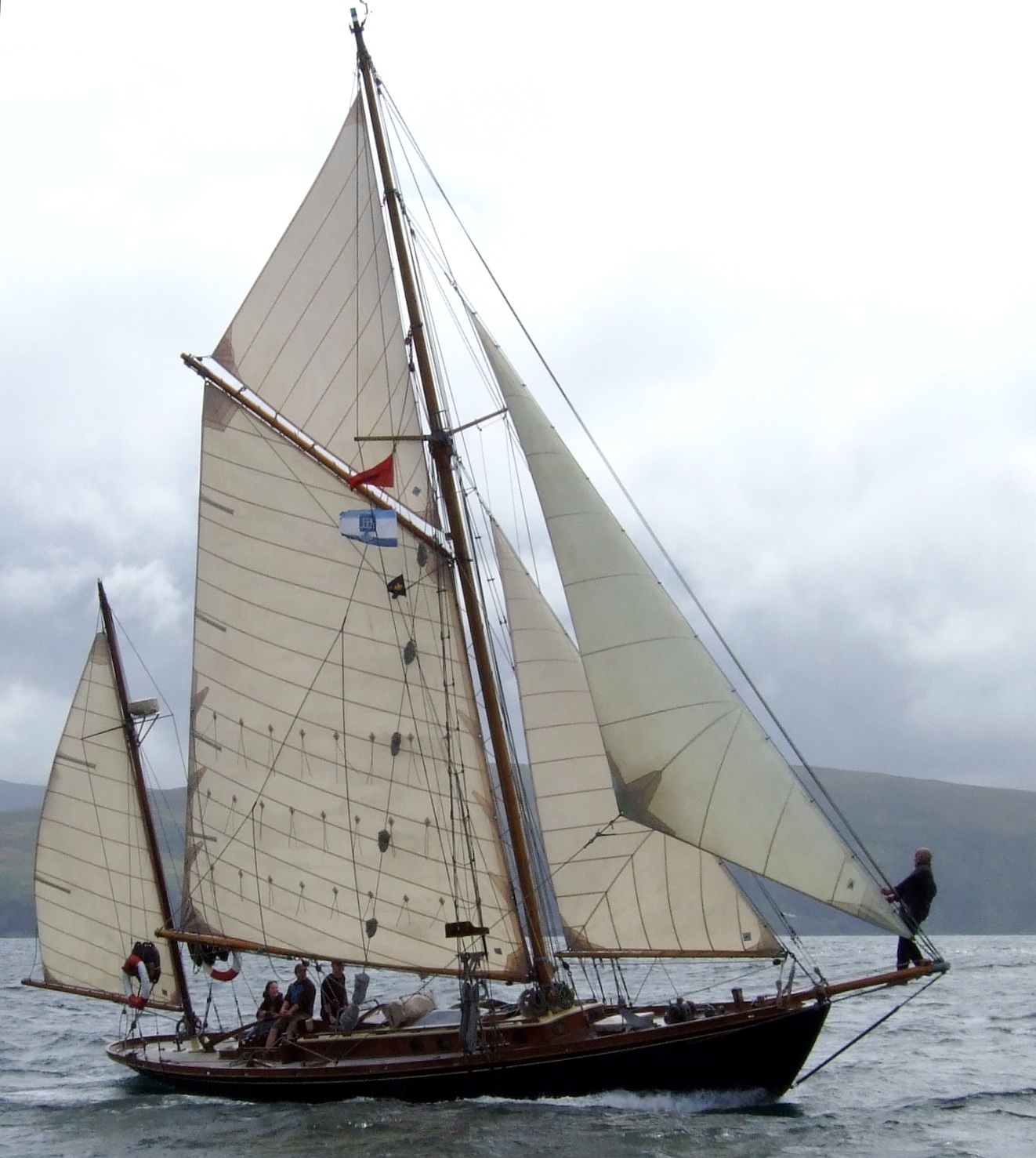
The 1902-built Espanola as she is today
Thus all the stars were in alignment for an historic and convivial meeting of the two old boats at the RIYC on the evening of Friday May 30th, the night before the Leinster Plate race was due to start just round the corner in Scotsmans Bay. But while stars may have been in alignment, ducks failed to get into a row, as Espanola with her exceptional draft of 7ft 6ins failed to get out of Preston over the shallow bar in the one tide which would have suited, on May 16th.
This situation is a useful illustration of the problems the old gaffer people face in keeping the show on the road with limited resources. Martin Birch, having been a lecturer in Lancaster University, had found Preston's little marina an ideal place to keep and maintain Espanola, and the marina in turn regarded the old girl as their pet boat. But Preston is longer a busy commercial port, so the channel has been left to is own devices, and with the huge tides of the Lancashire coast, getting Espanola to sea is quite a challenge as sometimes there's only one day in any month when it can be done.
So there we were, faced with the prospect of Hamlet without the Prince with just ten days to go to the historic gathering at the RIYC. But Jim Horan, affable Commodore of the Royal Irish YC, took it all in his stride and told us to bring Ainmara along anyway, it would be a good excuse for a Friday night party and he was keen to meet the skipper who had made the Round Ireland challenge very much his own 28 years ago.
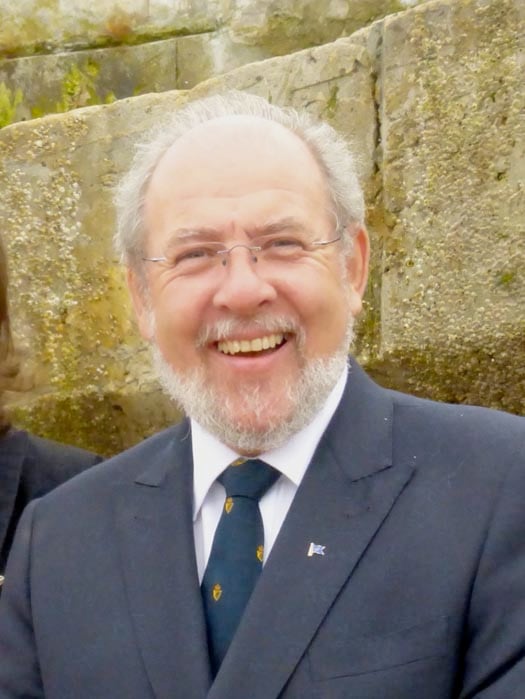
Jim Horan, Commodore of the RIYC, told us to come on and be welcome even though Espanola couldn't make it. Photo: W M Nixon
With the foul weather of mid-May, while Ainmara had got afloat from her winter quarters in a hayshed at the Gomes farm on the Ards peninsula in County Down, further fitting out was difficult in endless rain, and the skipper came down with a massive cold. But then the weather perked up, and he did too, so at lunchtime on Thursday My 29th we headed down Strangford Lough from the Down Cruising Club's former lightship headquarters at Ballydorn to catch the start of the ebb in Strangford Narrows at 1430 hrs.
Progress was good with a light to moderate nor'easter, but Ainmara and her crew (there were four of us – Brian Law, Ed Wheeler and I together with Dickie) have got to the stage where nights at sea are regarded to be the result of bad cruise planning. Yet if we were going to be comfortably in Dun Laoghaire for Friday evening, then only Port Oriel at Clogherhead made sense as an overnight. But Port Oriel, home to some of the best-maintained fishing boats on the coast, can become a very crowded place on a Thursday night.
However, a phone call to the uncrowned king of Clogherhead Aidan Sharkey – whom I'd first met back in the 1980s when our two boats were moored in Seal Hole at Lambay, where he was diving on the nearby 1854 wreck of the Tayleur - ensured there'd be a berth for us, and when we arrived in at sunset there was the man himself to direct us to a corner where we wouldn't inconvenience fishing boats, and moreover had access to a set of proper steps.
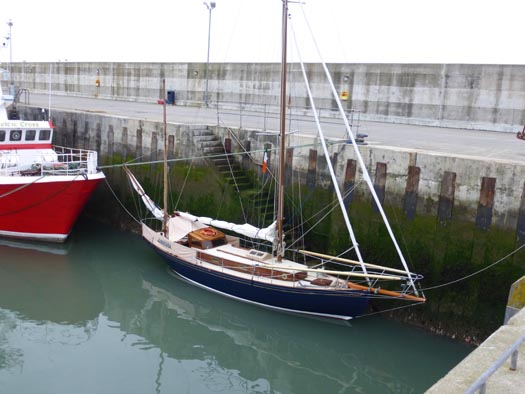
Port Oriel at Clogherhead provided Ainmara wih a handy overnight stop. There was more space available (below) as most of the 30-strong local fleet were away fishing the south coast. Photos: W M Nixon

Aidan's commitment to the maritime life is total. He's of an old Clogherhead fishing family, and he and his late brother Feargal were the backbone of the local beach-launched lifeboat crew. The banter was mighty on board Ainmara, leavened with tales of lifeboat experience which would curl your hair. The laughter through the companionway attracted others board, and soon Sean the razor clam man (all of his catches go straight to China) was in the hatchway with glass in hand, and when we asked where we might get a new deck scrub first thing in the morning as somehow the ship's own one had gone AWOL, Sean said not to worry, he'd throw one on board, and we could just leave it on the big fishing boat beside us as we left next day.
Ashore, I went up to Aidan's house in the village as he'd said he'd something to show me, which was an understatement. He was into the diving much earlier than most, thus when he got to wrecks which today are known to everyone, there were still intact bits of the cargo to be salvaged. Most east coast divers have fragments of chinaware, pottery and other artefacts from the Tayleur, but Sean had so many complete pieces, together with many other items of special antique value from other wrecks mostly in Donegal, that he would be well able to provide complete afternoon tea for the entire choir, all served on 1840s china. But it wasn't tea I got in the Sharkey household, it was Aidan's present of a large bag of fresh crab claws, and a selection of his own-cured salmon – smoked and gravid lax both – which sustained us through the next day's sail.
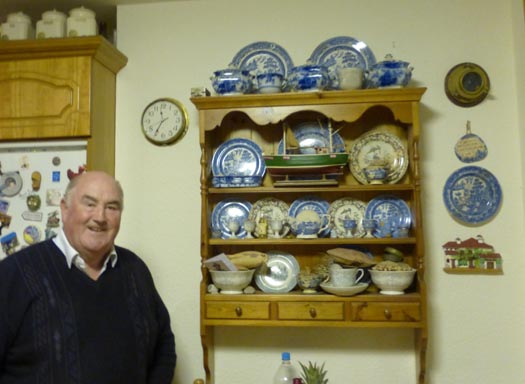
Aidan Sharkey of Clogherhead with some of his remarkable collection of salvaged chinaware. Photo: W M Nixon

The sort of sailing cruising folk dream of. Ainmara shaping up nicely to take the first of the fair tide through the islands at Skerries. Photo: W M Nixon
The morning brought the welcome gift of a decent little sunny east to nor'east breeze, and a lovely beam reach all the way down to Dublin Bay, with the south-going tide caught to perfection at the Skerries islands (and yes, I know it's superfluous to talk of the "Skerries islands", but that's what they're called to differentiate them from the Skerries off Holyhead).
Anyone who was involved in last weekend's ICRA Nationals at the Royal Irish YC will know how this premier club can lay on the welcome with effortless style. In the last weekend of May, Ainmara and her crew had the Royal Irish treatment all to themselves. Sailing Manager Mark McGibney ushered us to the prime berth right at the club where we found ourselves in a miniature maritime museum, with the Quarter Tonner Quest close astern (she was to become the ICRA National Champion a fortnight later), while just across the way was the S&S 36 Sarnia – back in 1966, the Sisk family set Irish sailing alight by bringing this very up-to-the-minute fin-and-skeg fibreglass boat back from builders Cantiere Benello in Italy, where they'd started series production on this ground-breaking Olin Stephens design before the same hull shape became better known as the Swan 36 built by Nautor in Finland.
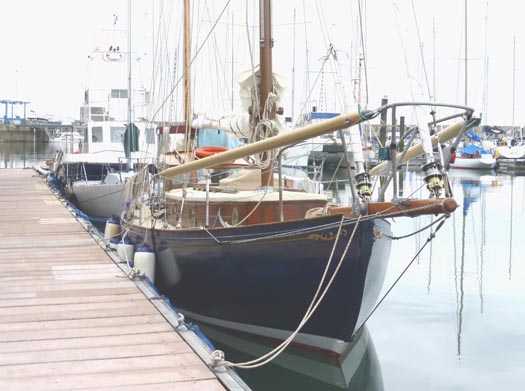
"Maritime museum" at the Royal Irish YC. Ainmara (built Ringsend 1912) with the 1987 Quarter Tonner Quest astern, and the 1966-built S&S 36 Sarnia across the way in her marina berth. Photo: W M Nixon
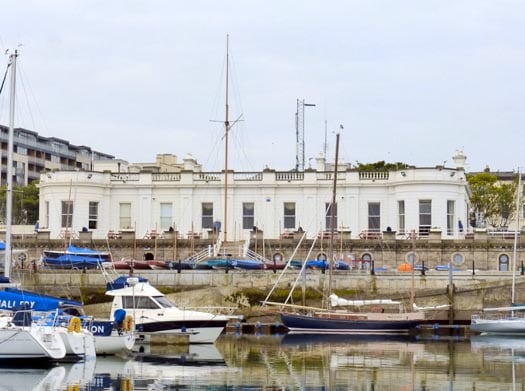
It has to be one of the best berths in the world. Ainmara at the RIYC – it's early morning, and the flags aren't yet hoisted. Photo: W M Nixon
The hospitality flowed seamlessly as the late afternoon graduated into evening and then velvet night. Ainmara is an extraordinarily effective calling card, and the stream of entertaining visitors brought laughter aboard before the Commodore moved us all up to the clubhouse and a fine supper and much chat with Michael O'Leary, one of the most visionary minds in Irish sailing, and his wife Kate and her people with tales of how she and longtime friend Clare Hogan are in the thick of things in the very healthy Water Wag class.
The RIYC took all this in its stride despite the fact that there was a big wedding going in the clubhouse at the same time, but it all went so smoothly that at one stage Ainmara's crew found themselves being invited to join in the wedding celebrations. However, we demurred because we were athletes in training for the Leinster Trophy next day, yet nevertheless certain key players in the wedding got themselves aboard Ainmara at a very late hour.
The plan for Saturday had been changed, but we were right up to speed with this as Denis Aylmer, the RIYC's key man in the OGA, had told us over a convivial pint that the likelihood of light winds had meant that Race Officer John Alvey had moved the scene of the action from Scotsmans Bay to a more compact race area close off the entrance to Dublin Port. It was all grist to our mill, as we could make an early morning departure and head up to Poolbeg Y & BC across a mirror-like bay, lining up the crew to salute the North Bank Lighthouse in the River Liffey, as it's something of a memorial to John B Kearney, whose day job was in the engineering department in Dublin Port and docks. With his original lighthouse, he pioneering a technique of screwing the piles into the seabed. You'd have thought an air of reverence would prevail, but with Ainmara's crew of anarchists, straight faces could only be maintained for about 12 seconds.
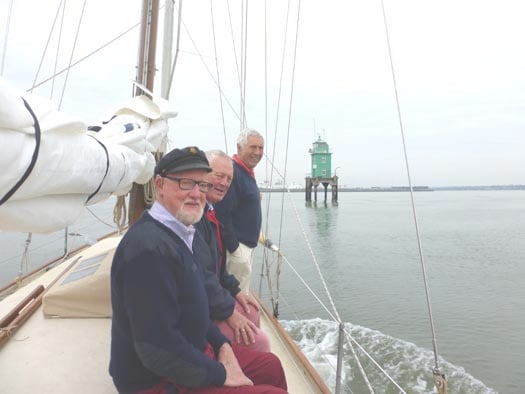
Trying to look appropriately reverential. Ed Wheeler, Brian Law and Dickie Gomes approaching Dublin Port's North Bank Lighthouse on which John B Kearney pioneered the use of screw piles. Photo: W M Nixon

"We're only here for the breakfast". Katy O'Connor's excellent catering in Poolbeg Y & BC is deservedly popular among visiting crews. Photo: W M Nixon
While we wanted to be well on time for the pre-race briefing, the main reason for getting promptly to Poolbeg was to take full advantage of Katy O'Connor's legendary breakfast at the club, and we put away enough calories to keep us going all day. At the briefing, John Alvey told us the committee were concerned that the very varied fleet – everything from Ainmara to the big Naomh Cronan, a superb Clondalkin-built re-creation of a Galway Hooker – included some boats which, in the light airs expected, could be out on the bay until nightfall.
So the plan was for a short race taking in several marks so that it could be finished at the end of any leg. But by the time we got down to Dublin Bay, it was crisp blue with a smart little sea breeze filling in to give sailing conditions which suited Ainmara to perfection, yet some of the heavier gaffers were still lumbering slowly about in what to them was a light wind.
They may have been lumbering about, but several were very determined to make a sharp start right on the committee boat. Anyone accustomed to quick-turning and fast-accelerating modern boats will find a fleet of traditional and classic gaffers a real education. They take time to get moving, they take for ever to stop, you point them a long way out, and their bowsprits – "dock probes" as marina managers call them – seem intent on skewering everyone else.
But while our skipper may pretend to be just an old cruising man these days, his racing blood was up. We set ourselves to sweep into what we hoped would be a gap starting to appear at the committee boat seconds after the start signal. We consoled ourselves with the thought that in extremis, we might just manage to shoot head to wind leaving the committee boat to port, ruining our start perhaps, but preserving the Ainmara intact.
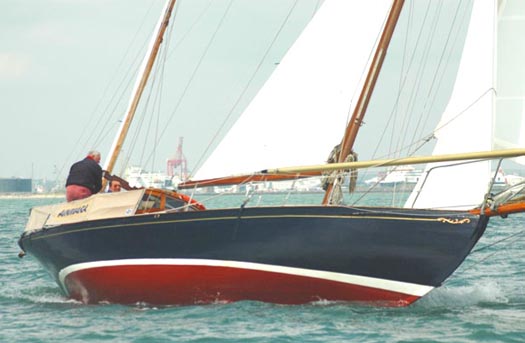
"Go for it, and let's hope there's a gap when we get there..." Ainmara starts to build speed towards her start in the Leinster Trophy Race 2014 . Photo: Gill Mills
So she was set at it, despite attempts to slow her a bit the speed built up, but as quickly as I'm telling this the gap started to appear and she zapped into it and just managed to keep her wind clear on Sean Walsh's remarkably fast Heard 28 Tir na nOg and Denis Aylmer's Mona. Now we had to find the DBSC marks in the right sequence, but Ed was on top of it feeding co-ordinates and giving out courses, we found that with a bit of luck we might just lay the first mark close hauled, and though Tir na nOg – whose waterline length is much the same as Ainmara's – hung in very well, he'd to tack for the mark while we scraped by it, so after that it was up jib tops'l and making hay.
But though we took line honours, we felt certain Tir na nOg would win on corrected time, as a Heard 28 sailed as well as she is can be one very potent performer, and Sean seemd to be still right on our stern at the finish. The results wouldn't be announced until Monday evening, so that Saturday afternoon we wandered back upriver to Poolbeg in sunshine so powerful that an afternoon zizz was your only man, and then we emerged on deck to find that others were arriving in port, with one of the the Welsh visitors, the engine-less Happy Quest from Milford Haven, making a copy-book job of berthing under sail, and then all was alive with the Howth Seventeens arriving in from their home port after a very close-fought passage race which had been narrowly won by Conor Turvey sailing Isobel.

Happy Quest from southwest Wales lives up to her name with a successful berthing under sail only at Poolbeg. Photo: W M Nixon
The Seventeens were there to put on a display race next day (Sunday) in the Liffey as part of the three day Dublin Port Riverfest over the Bank Holiday weekend. Inevitably for those of us who took part in the first one in 2013 when the OGA Golden Jubilee was top of the bill, there wasn't quite the same buzz, but first-timers watching aboard the restaurant ship Cill Airne assured us they found it very exciting indeed, and were especially impressed by the waterborne ballet of the two big harbour tugs Shackleton and Beaufort, while the funfairs and entertainment shows along the quays really did provide something for everything.
Once again the very sight of the Seventeens – which we in Howth tend to take for granted – was fascinating in the city setting. Though the promise of a decent breeze evaporated, Race Officer Harry Gallagher managed to get enough in the way of results to declare Peter Courtney with Oonagh the winner, an appropriate result for an historic class making a show performance, as the Courtneys have been involved with the Howth Seventeens since 1907.
I watched it all from an appropriate setting, aboard the Dutch Tall Ship Morgenster, a handsome 150ft brig which should be required visiting for anyone promoting the idea of a new Tall Ship for Ireland. For the Morgenster – which was re-configured as a sailing ship in 2009 – is run as a commercial venture, and can pay her way through being the right size to be a business proposition, helped by being based in the Netherlands. Thus she has a vast continental catchment area nearby to attract trainees of all ages and abilities who are prepared to pay enough for berths to keep the show efficiently on the road. There are several Dutch-based tall ships run in the same way, and the message is that if you're going to make a go of it commercially, you have to have a large enough and readily-accessed market to make it viable, and you need a boat big enough to carry sufficient trainees relative to the size of the ship – 36 in Morgenster's case – to balance the books.
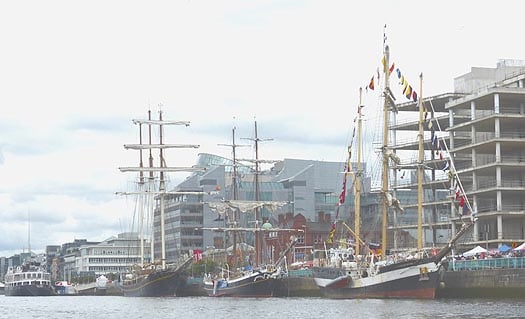
Tall ships in the Liffey, with the commercially-run 150ft sail training big Morgenster at centre. Photo: W M Nixon
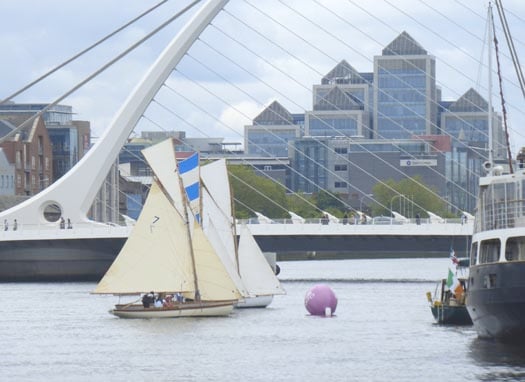
Sails and the city – Howth 17s at the Sam Beckett bridge Photo: W M Nixon
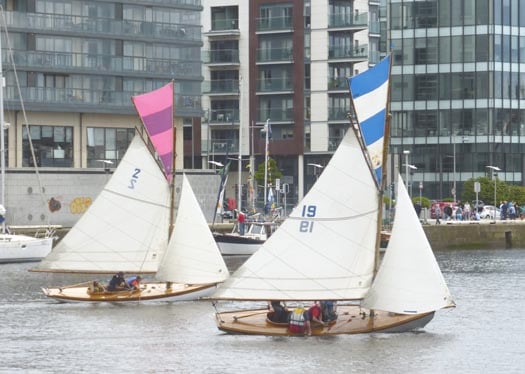
There was just enough wind for the first race for the Howth 17s to show what they could do in the Liffey if the breeze held up. Photo: W M Nixon
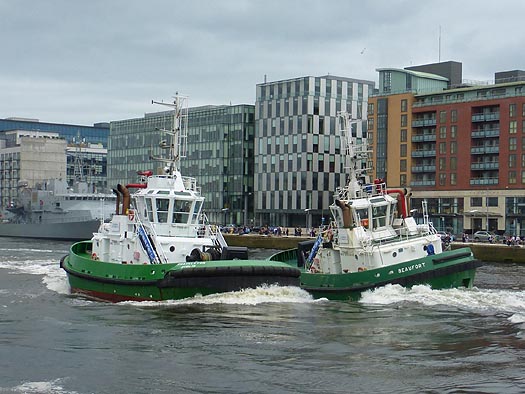
The Dublin Port tugs have awesome power to deploy in their waterborne "ballet" Photo: W M Nixon
But enough of solemnity. We went downriver again for farewells at Poolbeg, and then away across Dublin Bay and round the Baily for a seafood feast in Howth at the new place Crabby Jo's, and a handy overnight stop before using a good westerly next morning to give us a push towards Ardglass where we needs must stop, as the tides into Strangford Lough are a door slammed shut every six hours. But as ever, Ardglass's convenient and friendly little marina provided the perfect decompression chamber, and up in Mulherron's the crack was mighty with the crew of the famous restored Manx longliner Master Frank, just the two of them with skipper Joe Pennington - aka The Rat – being crewed by a psychiatrist who claimed to be strictly on holiday, but we did wonder, as any gathering of Old Gaffers is better than a wardful of nutters.
Ainmara's mini-voyage concluded next day with a text message from Dublin to tell us we'd retained the Leinster Trophy, which surprised us, and then with an idyllic sail in a sunny sou'wester, everything set to the jib tops'l, and all sail carried right through The Narrows, across Strangford Lough and thorough Ringhaddy Sound, and on across a blue sea among green islands past tree covered shores until we handed the sails just off the entrance to Down Cruising Club's isle-girt outer anchorage immediately south of Mahee Island, in a little sheltered area which has somehow acquired the unlovely name of Pongo Bay.

Home again. Ainmara back on her mooring in Strangford Lough, with Brian Law's classic yawl Twilight astern. Photo: W M Nixon
There, Ainmara is securely moored close to Brian Law's own cruising boat, the beautifully restored classic Lion Class yawl Twilight, designed by Arthur Robb. Like Dickie Gomes, Brian does all his own boatwork in a hayshed beside the house. So closely intertwined are their interests that they readily crew for each other, and of course the exchange of information and assistance and re-fit ideas is continuous.
And there's one further fact about these guys which may be of interest to other cruising crews. Aboard Ainmara during the three seasons in which I've cruised on her since she was restored for her Centenary in 1912, there's no kitty to cover expenses. There's an underlying feeling that as the skipper provides the boat, the crew owe him on a permanent basis. Thus if we get into a port and there's a choice between a comfortable marina berth or hanging off a quay wall, the crew will simply slip away and discreetly pay for a marina berth, and then tell the skipper it's a done deal.
Equally, when ashore for a meal, one of the crew will usually sidle off and pay for everyone when no-one else is looking. But if the skipper thinks the day has gone particularly well, you'll sometimes find he's paid for it all himself, As for getting diesel, whoever is carrying the cans will pay for it himself. Then too, when stores are required, it's covered by whoever goes to get them. It all sounds like an accountant's nightmare, yet so far, somehow at the end of the cruise everyone is content with the feeling that it has all balanced out, and as it has worked well for three years and longer, the attitude is that if it ain't broke, then don't try and fix it.
It had been hoped that Ainmara could stay on in the Dublin area for a week to do the Howth YC's Lambay Race in the Old Gaffers division on June 7th, as she won it in 1921. However, there was too much work still to be done to get her completely ready for a busy cruise programme coming rapidly down the line. But as she'll have to be back next year to defend the Leinster Trophy again, who knows but the double event might be done in 2015. As it was, her need for further fitting-out nearer to home was the saving of me, as a mighy temptation arose. The ancient Madcap from the north had stayed on in Dublin Bay, and was doing the Lambay Race with other old gaffers. The word on the waterfront is that Madcap may well be sold to France to be the centrepiece of a maritime museum in La Rochelle. So the Lambay Race might well be the last chance to sail on a 140-year-old boat. A place was secured on board.

The gaffers gather......Tir na nOg, Madcap and Naomh Cronan on misty morning in Howth before the Lambay Race. Photo: W M Nixon
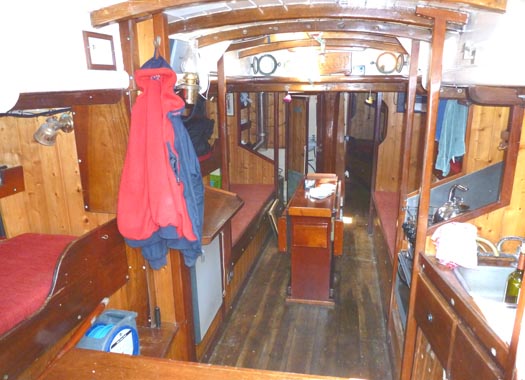
Madcap's sensible accommodation (above and below) reflects the seagoing needs of the pilots for whom she was built140 years ago. Photo: W M Nixon
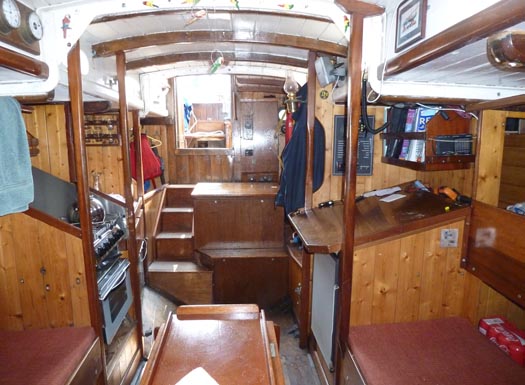
Madcap's owner for more than twenty years now has been Adrian "Stu" Spence, a rugged Belfast barrister who has the essential determination to keep such an ancient boat going. And going places too – he has been to Greenland and several times to Spain and Brittany, and has brought his old cutter through many a problem to log an impressive voyaging record.
If you have a boat of this age, your motto is: When God made time, he made a lot of it. Thus although the Old Gaffer's division was due to start at 1135, five minutes after the Howth Seventeens had set off through Howth Sound to sail the traditional Lambay course leaving Ireland's Eye to starboard and Lambay to port in order to celebrate the centenary of the Lynch family's Howth 17 Echo, it was pushing 1140 by the time we mde our leisurely debut to follow other other gaffers, which had Sean Walsh's keenly-sailed Tir na nOg soon disappearing into the misty asterly, followed by the Galway hooker Naomh Cronan helmed by the great Paddy Murphy of Renvyle, the Cornish crabber Alice (Mark Lynch) and then Madcp in her own good time.
With Northern Ireland Old Gaffers Association President Peter Chambers on the helm, Madcap settled gently into her stride, showing that she needs very little steering – she'll maintain a straight line for miles without the wheel being touched or secured in a any way. It's an oddly soothing characteristic, just the thing to calm a man down after a hectic week in the High Court, and she soon was making her own best speed with a bit of bite now in the breeze, putting Alice astern and keeping Naomh Cronan handily in touch.

"Is it always this foggy off Howth?" Stu Spence and Peter Chambers with he visibility closing in during the Lambay Race. Photo: W M Nixon
The mist became fog, but as ever it was difficult to tell just how thick it was until we suddenly found ourselves surrounded by wraiths in the gloom. It was Class 0 racing towards Lambay, and overtaking us just feet away, giving dramatic close-ups of some of the most likeable boats on the East Coast, with Stephen O'Flaherty's Spirit 54 Soufriere pacing it with Chris Hourican's First 47.7 Pretty Polly and the Tyrrell family from Arklow with their handsome J/122 Aquelina.
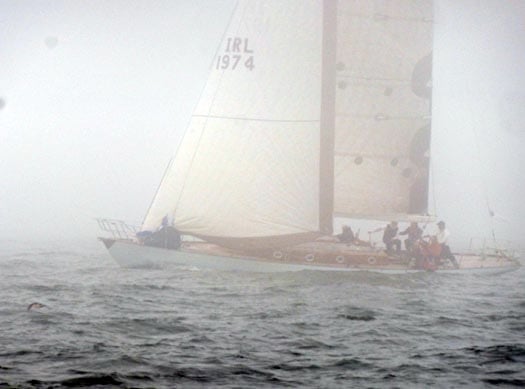
Do not adjust your sets, it really was this foggy for a while. Stephen O'Flaherty's Spirit 54 Soufriere in the fog during the Lambay Race Photo: W M Nixon

Chris Hourican's First 47.7 Pretty Polly in close-up Photo: W M Nixon
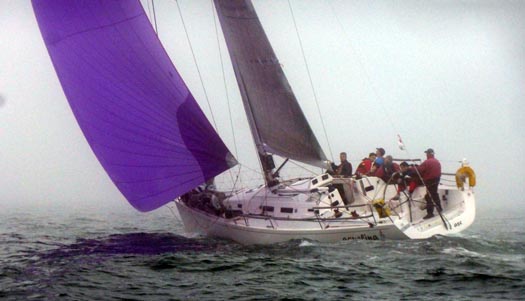
The Tyrrell family's J/122 Aquelina looking her best as she slices through the fog. Photo: W M Nixon
The fog was lifting as we got to the island with boats everywhere – the gaffermen were most impressed. Naomh Croanan had been overtaken, and Peter found us the perfect track along the flukey north side of Lambay, with Madcap effortlessly sliding over the smooth sea on a dead run and apparently consolidating her position.
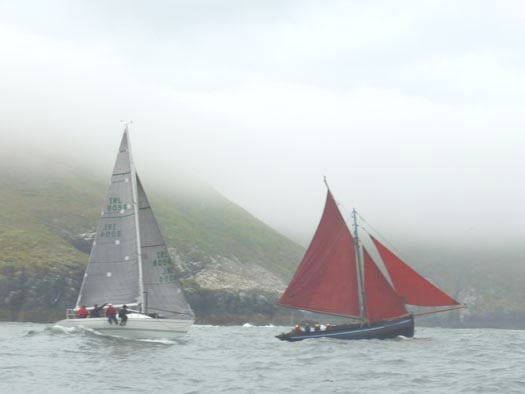
The fog start to lift. Dave Cullen's Half Tonner King One and te Naomh Cronan pproaching the east point of Lambay. Photo: W M Nixon
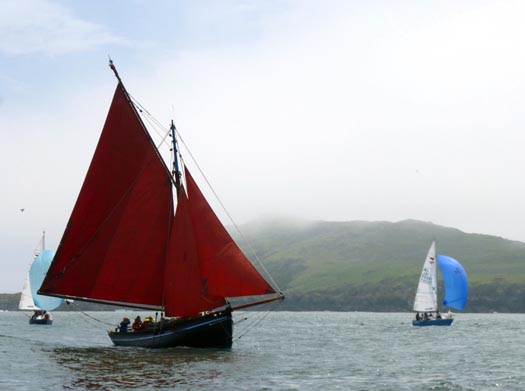
It could be Connemara...., .Naomh Cronan and two Puppeteer 22s off the north coast of Lambay Photo: W M Nixon

The long haul to the finish, the sun is out, and the breeze is beginning to develop enough power to suit Madcap. Photo: W M Nixon
But that was only until we started to head south back to the finish in Howth Sound. The Bermudan boats could lay it, so could the Seventeens, but poor old Madcap was even outpointed by Naomh Cronan, which Paddy Murphy very skilfully kept inside the line of foul tide in Lambay Sound and began to nibble at our lead, while we sagged to lee.
The sun was out, the sailing was lovely, we were surrounded by bustling classes of Puppeteer 22s and Ruffians 23s, and I suggested that a bit more tension in the jib luff, might do the trick, only to be told that as the bowsprit was no more than a liberated telegraph pole, it wasn't really up to the loads which would be put on it by trying to maximise the performance of a 22-ton boat, and nobody wanted splinters flying every which way aboard a boat where the mainboom looked to weigh at least half a ton.
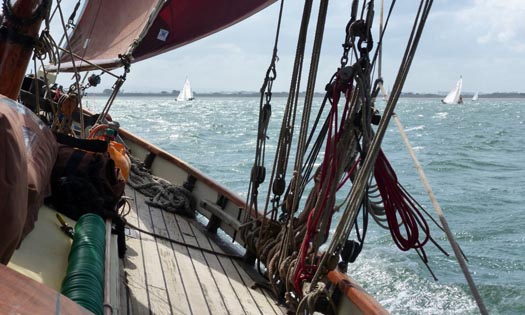
A bite to the breeze, with little boats everywhere – and all of them on starboard. Photo: W M Nixon

The Dun Laoghaire Ruffian 23s made a weekend of it for the Lambay Race, coming over on the Friday night, partying mightily, and then going out to race on Saturday in a rising breeze. Photo: W M Nixon
As it is the loads becme quite something as the breeze freshened sunny and squally down the north flank of the hjill of Howth. By the time we made it across the line, Madcap was going well on smooth water under just mainsail and staysail. But though Naomh Cronan was still ahead and rightly delighted with themselves at getting a good second, it was Tir na nOg which had been in race of her own. Yet as Sean Walsh reported with astonishment, he hadn't been able to get among the slippy little Howth 17s, where John Curley and Marcus Lynch had a good win with Rita, Howth Seventeen No. 1.
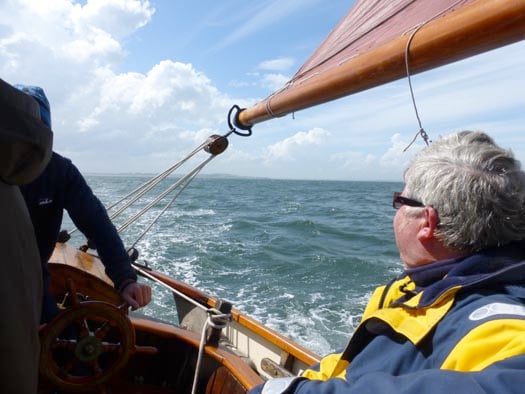
Finally there was enough breeze for Madcap's wake to stretch satisfyingly astern while she could point better with the jib brought in, but Naomh Cronan still finished ahead to take second prize. Photo: W M Nixon

The mighty helmsman of Renvyle. Paddy Murphy (left) steered Naomh Cronan to an excellent performance in the Lambay Race 2014. With him is DBOGA Hon Sec Gerry Murtagh with a trophy he won racing round Lambay in 1986. Photo: W M Nixon
It seemed an Old Gaffers Classic Lambay Race had been inaugurated, and Sean Walsh, international President of the OGA, was most appropriately the first winner. It was something to celebrate, and it duly was, in the sunshine at Howth YC. But in time, I had to take myself away and go for a long walk with the little dog along the beach. For when you've been sailing on a 140-year-old boat, there's a need to ponder the passing years, and this crazy sport of ours in which museum pieces are part of the action.




























